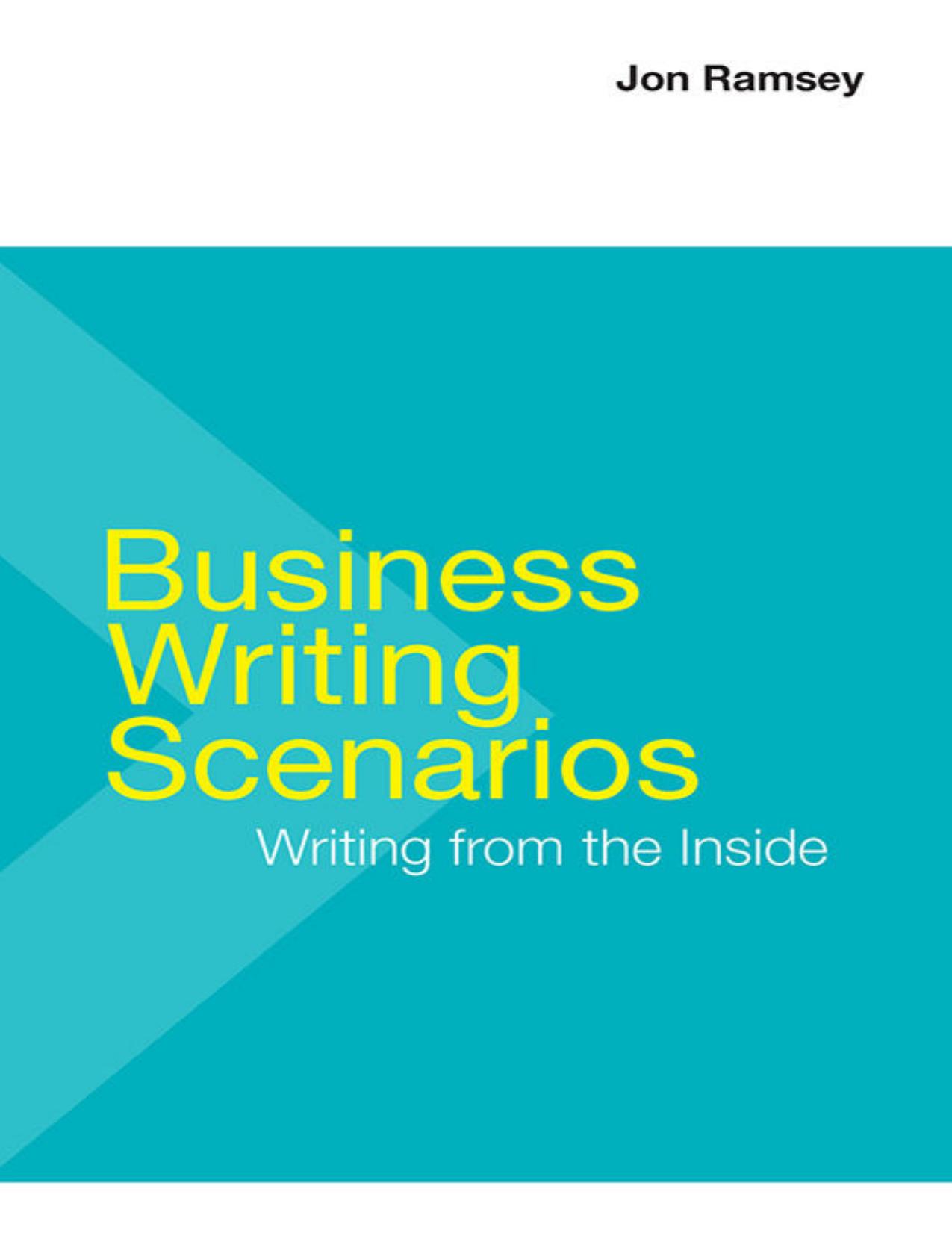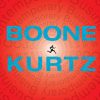Business Writing Scenarios Writing from the Inside 1st edition by Jon Ramsey 9781319117160 1319117163
$70.00 Original price was: $70.00.$35.00Current price is: $35.00.
Instant download Business Writing Scenarios Writing from the Inside 1st Jon Ramsey after payment
Business Writing Scenarios Writing from the Inside 1st edition by Jon Ramsey – Ebook PDF Instant Download/Delivery: 9781319117160, 1319117163
Full dowload Business Writing Scenarios Writing from the Inside 1st edition after payment

Product details:
• ISBN 10:1319117163
• ISBN 13:9781319117160
• Author:Jon Ramsey
Business Writing Scenarios: Writing from the Inside
Business Writing Scenarios Writing from the Inside 1st Table of contents:
Chapter 1 The Purposes and Concepts of This Book
Understanding the Nature of Business Writing
Previewing the Basics
An Example of Unspecific, Unfeeling Business Writing
An Example of Specific, Empathetic Business Writing
The Foundations of Effective Business Writing
Imagining Your Way inside Business Situations
The Scenarios in This Book
Sample Scenario: A New Employee Introduces Herself
Sample Scenario: A Manager Politely Declines a Colleague’s Request
Writing to Build and Maintain Relationships
Choosing the Medium
Factors to Consider
Examples of Selection Strategies
Writing to Achieve Your Purpose—and Get Results
Explaining, clarifying, or providing information.
Defending.
Negotiating.
Appeasing, mollifying, ameliorating, or apologizing.
Persuading, requesting, or marketing.
Constructing policies and procedures.
Proposing new or modified organizational practices and directions.
Responding to Real-World Writing Scenarios
Analyzing a Writing Scenario: Explaining a Workplace Disruption
The Challenges of Explaining the Disruption
An Ineffective Explanation of the Disruption
Applying What You’ve Learned
Application 1-A: Explain a Workplace Disruption
An Effective Explanation of the Disruption
Analyzing a Writing Scenario: Responding to a Former Colleague Who Wants Confidential Information
Applying What You’ve Learned
Application 1-B: Respond to a Former Colleague Who Wants Confidential Information
Looking Ahead
Chapter 2 An Overview of Business Writing
Understanding the Central Concerns of Business Writing
Seeing the Big Picture
Starting with You as Person, Employee, and Writer
Understand Your Level of Authority
Look before You Leap—and Stay Alert for Opportunities
Familiarize Yourself with Your Organization’s Principles and Values
Keeping Your Purpose in Mind
Understanding Your Audience and Audience Psychology
Determining a Communication Strategy
The Importance of Evidence
The Importance of Tone
Paying Attention to Details
Using Clear Vocabulary
Proofreading
Responding to Real-World Writing Scenarios
Analyzing a Writing Scenario: Explaining a Policy Change
The background.
The purpose.
The audience.
The communication strategy.
A First-Draft Explanation of the Policy Change
A More Detailed Explanation of the Policy Change
Analyzing a Writing Scenario: Weighing the Costs and Benefits of Conciseness
A Brief, Formulaic E-mail
A More Developed E-mail: Example 1
A More Developed E-mail: Example 2
An E-mail That Offers Specifics and a Longer, More Detailed Document
Applying What You’ve Learned
Application 2-A: Inquire about Office-Space Needs
The background.
The purpose.
The audience.
The communication strategy.
Application 2-B: Seek Volunteers for a Nonprofit Organization
The background.
The purpose.
The audience.
The communication strategy.
Application 2-C: Coordinate Accounts Receivable Information
The background.
The purpose.
The audience.
The communication strategy.
Chapter 3 Résumés, Cover Letters, and the Job-Search Process
Understanding the Application Process
Assessing Your Abilities: What Do You Have to Offer?
Investigate Campus Resources
Ask Yourself Questions
Identify Your Research Skills
Assembling Your Credentials
Finding Open Positions
Unadvertised Opportunities
Advertised Openings
Dos and Don’ts
Improving Your Odds in the Application-Review Process
Surviving the First Cut
Increasing Your Chances of Success
Responding to Real-World Writing Scenarios
Analyzing a Writing Scenario: Crafting an Effective Résumé
A Problematic Résumé
The overall design.
The header.
Career objective.
Education.
Work experience.
Skills.
Revisions to the Résumé
The header.
Career objective.
Education.
Work experience.
Skills.
References.
The Final Product
Résumé Tips
Give yourself the space you need.
Create a clear and attractive document.
Be sure that any “goals” or “career objective” statements serve a real purpose.
Don’t sell past jobs short.
Include the following skills, evidence, and experience, when applicable:
Analyzing a Writing Scenario: Crafting an Effective Cover Letter
A Problematic Cover Letter
Revisions to the Cover Letter
The letter format.
The opening.
The middle paragraphs.
The closing.
Cover Letter Tips
Stay focused on getting interviews.
Pay attention to details.
Get off to a strong start.
Base your letter on concrete evidence rather than on claims.
Describe some of the relevant content of your university studies to employers.
Stress throughout the letter what you can offer the company, not what you hope to gain from being employed there.
Close the letter with a very brief reminder of your strongest attributes.
Exploring Additional Examples of Résumés and Cover Letters
A Résumé and Cover Letter from a Liberal-Arts Student
A Résumé and Cover Letter from a Business/Economics Student
Applying What You’ve Learned
Application 3-A: Create Your Own Cover Letter and Résumé
The background.
The purpose.
The audience.
The communication strategy.
Getting from the Application to Success
Following Up on Your Application Materials
Acing the Job Interview
Do your research.
Dress the part.
Be prepared.
Expect difficult questions.
Conclude on a strong note.
Stay in touch after the interview.
Interview Tips
Research the company to which you are applying
Dress appropriately
Show up for the interview 15 minutes early
Plan ahead for both the open-ended and behavior-specific questions
Prepare some insightful questions
Mail or e-mail a thank-you note after the interview.
Starting and Pursuing a Rewarding Career
Checklist: Overview of the Job Search
Chapter 4 Business Document Design, Formats, and Conventions
Understanding Key Features of Document Design
Previewing Design Basics
Melding Structure and Purpose
Elements of Effective Design
An Example of a Clearly Designed Memo
Why the Design Succeeds
Exploring Common Formats for Business Documents
The Business Letter
Block letter format
Standard E-mail Format
Standard e-mail format
Common Memo Format
Common memo format
Incorporating Visual Materials into Your Text
Avoid Do-Nothing Graphics
Provid Context
Designing Longer Documents
Following Other Style and Format Conventions
Salutations, or “You Lost Me at Hello”
Appropriate Salutations
Inappropriate Salutations
Type Size and Style
Margins
Text Breaks
Bullets
Pagination
Headers
Responding to Real-World Writing Scenarios
Analyzing a Writing Scenario: Improving a Poorly Crafted Memo
Applying What You’ve Learned
Application 4-A: Revise a Poorly Crafted Memo
Chapter 5 Writing to Colleagues within the Organization
Understanding the Challenges of Writing to Colleagues
Keeping Special Issues and Controversies in Mind
Respecting Co-workers across Business Cultures
Some Good News about Workplace Dynamics
Potential Consequences of Angry Communications
Responding to Discourteous Communications
Distinguishing Friends from Professional Colleagues
Conveying Negative News
Negative News Pitfalls
Responding to Real-World Writing Scenarios
Analyzing a Writing Scenario: Conveying Bad News about a Holiday Gift
An Off-Putting Message about the Gift
A More Thoughtful Message
Analyzing a Writing Scenario: Conveying Bad News about Medical Benefits
The Background
The Basic Facts about the Benefit Changes
Advice on conveying the News
An Effective Memo about the Benefits Changes
Applying What You’ve Learned
Application 5-A Revise an Off-Putting Request for a Promotion
The background
The purpose.
The audience.
The communication strategy.
Application 5-B Request Information about Office Supplies
The background.
The purpose.
The audience.
The communication strategy.
Application 5-C Revise a Poor Communication about Office Space
The background.
The purpose.
The audience.
The communication strategy.
Application 5-D Revise a Poor Communication about Child-Care Policies.
The background.
The purpose.
The audience.
The communication strategy.
Application 5-E Revise a Poor Communication about Flexible Work Schedules
The background.
The purpose.
The audience.
The communication strategy.
Application 5-F Revise a Poor Communication about Holiday Office Coverage.
The background.
The purpose and audience.
The communication strategy.
Application 5-G Revise a Poor Communication about Emoloyee Parking
The background.
The purpose.
The audience.
The communication strategy.
Chapter 6 Writing to External Constituencies
Understanding the Challenges of Writing to External Audiences
Knowing That Word Gets Around
The Pluses and Minuses of More Open Communications
Legal Implications of Problematic Communications
Principles of Respectful Communications
Providing Information Clearly and Persuasively
An Effective Response to an Information Request
An Ineffective Alternative
Keeping the Human Touch in Big-Business Communications
Avoiding Business Liabilities
Responding to Real-World Writing Scenarios
Analyzing a Writing Scenario: Responding to a Customer Complaint
The Complaint
One Effective Response to the Complaint
Another Effective Response to the Complaint
Applying What You’ve Learned
Application 6-A: Respond to an Information Request from a Potential Investor
The background.
The purpose.
The audience.
The communication strategy.
Application 6-B: Write a Company Mission Statement
The background.
The purpose.
The audience.
The communication strategy.
Application 6-C: Create a Return Policy for a Retail Store
The background.
The purpose.
The audience.
The communication strategy.
Application 6-D: Resolve a Complaint about a Catering Fiasco
The background.
The purpose.
The audience.
The communication strategy.
Application 6-E: Resolve a Complaint about Customer Service
The background.
The purpose and audience.
The communication strategy.
Note.
Application 6-F: Revise an Angry Complaint about a Cleaning Service
The background.
The purpose and audience.
The communication strategy.
Application 6-G: Revise a Letter That Delivers Bad News Insensitively
The background.
The purpose.
The audience.
The communication strategy.
Application 6-H: Respond to a Request from a Privileged Alum
The background.
The purpose.
The audience.
The communication strategy.
Note.
Application 6-I: Write a Rejection Letter
The background.
The purpose.
The audience.
The communication strategy.
Application 6-J: Invite a Distinguished Guest to a Campus Event
The background.
The purpose.
The audience.
The communication strategy.
Note.
Application 6-K: Disinvite Participants to a Focus Group
The background.
The purpose.
The audience.
The communication strategy.
Application 6-L: Reassure a Nervous Customer
The background.
The purpose and audience.
The communication strategy.
Application 6-M: Buy Time in a Tricky Situation
The background.
The purpose.
The audience.
The communication strategy.
Application 6-N: Request Permission from an External Constituency
The background.
The purpose.
The audience.
The communication strategy.
Student Responses to Selected Applications
Responses to Application 6-E: Resolve a Complaint about Customer Service
Responses to Application 6-H: Respond to a Request from a Privileged Alum
Response to Application 6-J: Invite a Distinguished Guest to a Campus Event
Chapter 7 More Complex Business Writing Projects
Understanding the Challenges of More Complex Writing Projects
Identifying Key Considerations of Complex Projects
The Situation or Scenario
The Audience
Background Research and Preparation
Document Design
Previewing Longer Writing Projects
A Business-Travel Reimbursement Policy
An Ethics Advisory Memo
A Request for Proposals
A Letter of Inquiry Preceding a Full Grant Proposal
A Grant Proposal
A Business Plan
Being an Effective Part of a Team
Responding to Real-World Writing Scenarios
Applying What You’ve Learned
Application 7-A: Draft a Business-Travel Reimbursement Policy
The background.
The purpose.
The audience.
The communication strategy.
The parts of the policy document.
The expense reimbursement form.
Further help on this project.
Application 7-B: Write an Ethics Advisory Memo
The background.
The purpose.
The audience.
The communication strategy.
Contents of the ethics advisory memo.
Further help on this project.
Application 7-C: Write a Request for Proposals (RFP)
The background.
The purpose.
The audience.
The communication strategy.
Further help on this project.
Application 7-D: Write a Letter of Inquiry Preceding a Full Grant Proposal
The background.
The purpose.
The audience.
The communication strategy.
Contents of the letter of inquiry.
Further help on this project.
Application 7-E: Write a Grant Proposal
The background.
The purpose.
Education
Energy/environment
Animals
The arts
Health
Economic concerns
International understanding
Community service
The audience.
The communication strategy.
Contents of the grant proposal.
Further help on this project.
Note:
Application 7-F: Write a Business Plan for a Start-Up
The background for business plans.
The background for this application.
The purpose.
The audience.
The communication strategy.
Contents of the business plan.
Further help on this project.
A final note on research.
Student Responses to Selected Applications
Response to Application 7-B: Write an Ethics Advisory Memo
Case 22
Response to Application 7-C: Write a Request for Proposals
Response to Application 7-D: Write a Letter of Inquiry Preceding a Full Grant Proposal
Response to Application 7-E: Write a Grant Proposal
Response to Application 7-F: Write a Business Plan for a Start-Up
Chapter 8 Business Writing Gaffes in the Real World
Reviewing Key Causes of Writing Gaffes
Touring a Gallery of Gaffes
Getting the Job the Wrong Way
Kicked out of Harvard
Dismissed as Admissions Dean
Fired as CEO of Yahoo! Inc.
Insulting Co-workers
Issuing an Apology without Acknowledging Any Responsibility
Correcting the Record . . . Sort of
“Spinning” a Bad Public-Relations Situation
E-mailing Your Way to a Legal Loss
E-mailing Your Way to Disgrace—and Bankruptcy
Confusing the Issue with Too Many Details
Sending an E-mail to the Wrong Recipient—and Jeopardizing a $1 Billion Settlement
Mass E-mailing Your Way to an Embarrassing Mistake
Mass E-mailing Your Way to a Financial Mess
Making Confidential Business Information Public (via E-mail)
Making Personal Information Public (via E-mail)
Writing in Code—with Potentially Detrimental Effects
Posting Your Way to Disgrace
Botching Communications from the Top: Hewlett-Packard
Botching Communications from the Top: Netflix
Making (Expensive) Punctuation Mistakes
Making Serious Social-Media Errors
Complaining about a Customer through Reddit
Complaining about a New Job on Twitter
Insulting a Key Client (and Others) on Twitter
Mixing Personal Expressions with Company Communications
Timing a Tweet Poorly
Exploiting a Bad Situation
Final Advice: Refer to Social-Media Guidelines
Chapter 9 Leadership Values in Business Writing
Reflecting on Leadership Values in Business Writing
Realizing That Many Leadership Skills Can Be Learned
Identifying Leadership Qualities
Clarity of Mind and a Commitment to Evidence-Based Decisions
A Commitment to Customer or Client Satisfaction
A Clear View of Long-Range Goals with a Readiness to Change
Equanimity in Troubled Times and an Ability to Operate above the Fray
A Willingness to Consider Others’ Ideas and Credit Their Contributions
Responding to Real-World Writing Scenarios
Application 9-A: Request Volunteer Help
The background.
The purpose.
The audience.
The communication strategy.
Application 9-B: Lead Colleagues in a New Direction
The background.
The purpose.
The audience.
The communication strategy.
Application 9-C: Convey Disappointing News about Health Benefits
The background.
The purpose.
The audience.
The communication strategy.
Where to Find Scenarios and Applications
People also search for Business Writing Scenarios Writing from the Inside 1st:
business writing scenarios writing
business writing examples
business writing skills examples
business writing format example
business writing scenarios


